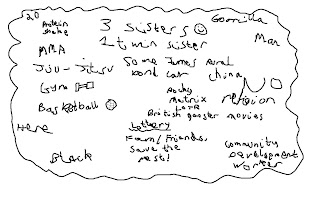Ruth, I will do my very best to bribe and coerce you into giving me top marks, though I will do the work to the best of my ability just in case that strategy fails.
Now, on to the subject matter itself.
Judging the Randoms
I consider myself a rather judgemental person, however when asked to make assumptions about 2 people standing right in front of me, I found it to be quite a challenge. My instincts, or rather my learned ability to judge based on my previous experience told me quite a lot, however I found myself denying the impulse to go with these instincts and approach the task from a more analytical point of view. As a result I didn't come up with to many assumed characteristics for the 2 young women, other than that they were young women of course! To my surprise many of the students managed to accurately predict several things about the volunteers, such as their music preferences, their personality quirks and even where they were born (or there abouts).
This strongly suggests that while our pre-defined categories we have for people are not always 100%, they can give a good indication of what kind of people we are actually dealing with.
After drastically lowering the volunteers self esteem, we then moved on to the egg task. I like eggs, they are high in protein and can taste good, but that's neither here nor there. We were asked to draw a shape on a large piece of paper and told any shape would do. Some people went for big triangles, others went for little squares, I personally went for a sheep with no legs.
We were then asked a series of questions. Do we have any brothers or sisters? Whats our favourite film? After answering these questions we were then given someone else's piece of paper and based upon what they had drawn and written, we were asked to deduce who's piece of paper sat in front of us. Once again I was surprised to learn that several people, including myself, were able to predict who's piece of paper we had.
So, how does this relate to understanding the customer?
What I took from the lesson with Ruth is that with a little bit of information about people, we can find out with some degree of accuracy a lot more about them. This information can be put to great use. It can be used to target specific people with advertising about specific products and services that there is a good chance of them buying. This method can be very effective, not only does it increases the chance of the potential customer buying the product but In doing so it also reduces your costs. If 10 out of 100 people will buy your product if they are made aware of it then why waste time with the other 90?
Amazon.com gives us a great example of this strategy. Upon purchasing any item, amazon comes up with a list of other items they feel you would be interested in based upon your purchase. Here's an example:
Based upon one piece of information, in this case the purchase of a CD, Amazon is able to recommend other products to me that I am likely to buy. By Judging me and making a perception of the style of music I like they are dramatically increasing the chance that I will purchase from them again by advertising to me as an individual with a product range specific to me.
That's all of my thoughts on the lecture for now, I look forward to the next one!


This is excellenty. You have a great writing style which makes for very interesting postings. Great fun too! I do expect to be bribed and coerced at every corner but obviously it will not effect my judgement at all :) (Chocolate normally works) Q: What do youcall a sheep with no legs? A: A cloud :) And there's plenty more where that came from
ReplyDelete